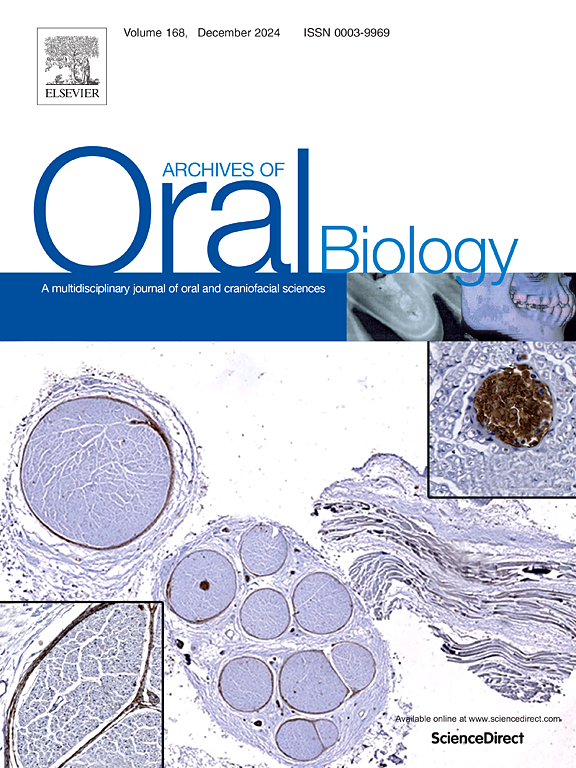A cone beam computed tomography study on the osseous morphology of temporomandibular joint with free loss of posterior teeth
IF 2.1
4区 医学
Q2 DENTISTRY, ORAL SURGERY & MEDICINE
引用次数: 0
Abstract
Objective
The purpose of this retrospective study is to explore the association between free loss of posterior teeth (FLP) including bilateral (BFLP) and unilateral (UFLP) free loss of posterior teeth and the osseous morphology of temporomandibular joint (TMJ).
Design
The condylar volume(V) and surface area(S), condylar mediolateral diameter (CD), horizontal condylar angle (HCA), glenoid fossa depth (GFD) and articular eminence inclination (AEI) of the bilateral TMJs were measured by using cone-beam computed tomography (CBCT) and Mimics software. The study included 120 FLP patients (UFLP=60, BFLP=60) and 60 controls with complete dentition. The differences between and within groups were statistically analyzed by SPSS 26.0. A two-way ANCOVA was employed to analyze the interaction effects among FLP, sex, and age on TMJ osseous morphological changes.
Results
In the UFLP group, both CD and AEI of the missing side were greater than those of the non-missing side(p < 0.05). Between groups, the GFD of the control group was significantly greater than those of the BFLP group and the missing side and non-missing side of the UFLP group (p < 0.05). Two-way ANCOVA demonstrated significant sex-based differences in TMJ morphology (V, S, CD, GFD, AEI; p < 0.05), with pronounced FLP × sex interactions for V, S, and CD (p < 0.001). Age predominantly influenced GFD (p < 0.001), surpassing FLP and sex effects (p < 0.05).
Conclusions
FLP was associated with shallower glenoid fossa morphology. Patients with UFLP showed asymmetric TMJs, with reduced CD and a flatter articular eminence on the non-missing teeth side. FLP-associated TMJ changes require careful consideration of sex and age factors.
后牙游离缺失的颞下颌关节骨形态的锥形束计算机断层研究
目的探讨双侧(BFLP)和单侧(UFLP)后牙游离缺失与颞下颌关节(TMJ)骨性形态的关系。设计采用锥形束计算机断层扫描(CBCT)和Mimics软件测量双侧颞下颌关节的髁突体积(V)和表面积(S)、髁突内外侧直径(CD)、髁突水平角(HCA)、关节窝深度(GFD)和关节隆起倾角(AEI)。本研究纳入120例FLP患者(UFLP=60, BFLP=60)和60例具有完整牙列的对照组。采用SPSS 26.0软件对组间及组内差异进行统计学分析。采用双向ANCOVA分析FLP、性别和年龄对TMJ骨形态变化的交互作用。结果UFLP组缺失侧的CD和AEI均大于非缺失侧(p <; 0.05)。两组间,对照组的GFD显著大于BFLP组及UFLP组的缺失侧和非缺失侧(p <; 0.05)。双向ANCOVA显示TMJ形态学存在显著的性别差异(V、S、CD、GFD、AEI;p <; 0.05),V、S和CD存在明显的FLP × 性别相互作用(p <; 0.001)。年龄主要影响GFD (p <; 0.001),超过FLP和性别影响(p <; 0.05)。结论flp与较浅的盂窝形态有关。UFLP患者表现为颞下颌关节不对称,CD减少,非缺牙一侧关节隆起扁平。与flp相关的TMJ改变需要仔细考虑性别和年龄因素。
本文章由计算机程序翻译,如有差异,请以英文原文为准。
求助全文
约1分钟内获得全文
求助全文
来源期刊

Archives of oral biology
医学-牙科与口腔外科
CiteScore
5.10
自引率
3.30%
发文量
177
审稿时长
26 days
期刊介绍:
Archives of Oral Biology is an international journal which aims to publish papers of the highest scientific quality in the oral and craniofacial sciences. The journal is particularly interested in research which advances knowledge in the mechanisms of craniofacial development and disease, including:
Cell and molecular biology
Molecular genetics
Immunology
Pathogenesis
Cellular microbiology
Embryology
Syndromology
Forensic dentistry
 求助内容:
求助内容: 应助结果提醒方式:
应助结果提醒方式:


